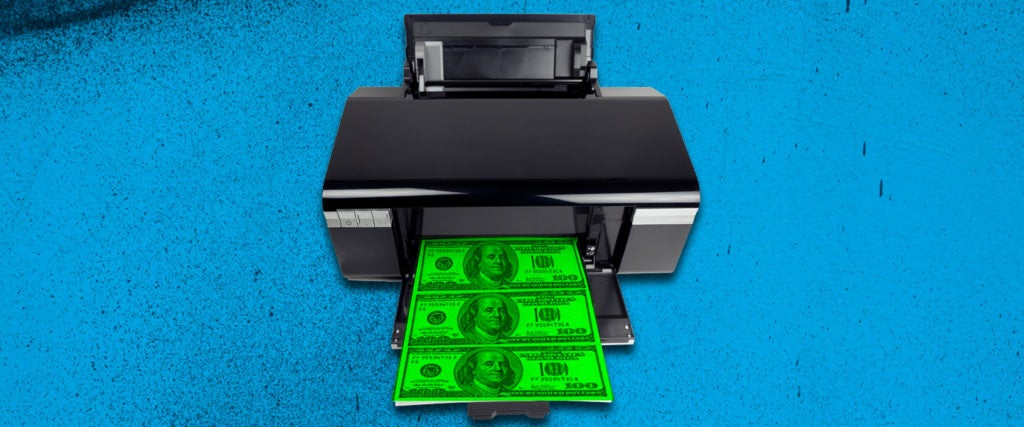Back in the old days of early 2020 when employees went to work in offices, they’d use the company printer to print out, on average, a little more than one non-work item each week. (More than a quarter of workers have printed out their resume for a job application on the company printer of their current employer.) Whether you were printing out plane tickets or personal photos, or even actual work documents, you never had to think about ink — that’s for the IT desk to fuck with!
But nowadays, many home office setups include a printer. But the cost of a printer pales in comparison to the price of ink. Why? Is this some kind of racket? What the hell is special about ink, anyway? We printed out some answers about the economics of a machine that most people hate to begin with.
Why is printer ink so expensive?
It’s part of the very business model of printers. “Think of the original price tag of a printer more like a down payment,” says Rich Sulin, who tests printers for Consumer Reports. One company, IHS Markit, disassembles various consumer electronics and estimates the cost to build them. It turns out that some printers are sold at a loss: A $70 HP printer actually costs $120 to manufacture. (PlayStations appear to also sell for less than they cost to manufacture.)
Printer manufacturers hook you by selling you the product for cheap, and the replacement parts for a lot more money. Printer ink is proprietary and non-compatible with other brands, so they do their best to erect a fence around your purchase. According to Consumer Reports, over five years, ink for some printers can cost up to $700!
What about those off-brand cartridges, though?
Yes, going generic can save a lot of money — that’s why printer manufacturers do everything they can to prevent it! One of the main things they do is run software that recognizes their own brand of cartridge (that’s one reason ink cartridges have microchips in them). All those insane firmware updates that your printer tells you it needs to run? Those are to prevent the use of third-party ink. There are as many as 900 firmware updates issued in a year in total from nine printer manufacturers — that’s how closely these companies guard their ink business.
What’s up with the third-party ink market, anyway?
It’s a big deal — even the Supreme Court has dealt with them in 2017, ruling that third-parties are legally allowed to refill a toner cartridge made by an original manufacturer. Prices and the amount of ink each printer uses vary wildly, but off-brand ink can cost 50 percent less, or sometimes even less than that (1.5 cents per page versus 9 cents). Quality seems to vary, according to tests and surveys: Some off-brands work just as well as the printer-brand ink, while others don’t.
But in addition to everything else printer manufacturers do to cock-block third-party companies, they can void the warranty on your printer if the third-party cartridge somehow breaks your machine. If you’re wondering how they can possibly know what cartridge you used, well, your printer figures it out and sends that info over the internet. Little shit.
What’s so special about ink, though?
Printer ink is apparently pretty sophisticated stuff. In what definitely sounds like a printing error, a while back, HP claimed it spends $1 billion a year on printer ink R&D (its printing division has revenues of 24 times that).
Jesus Christ, why?
Well, as Consumer Reports says, it’s got to fire thousands of drops of four different colors of ink per second with accuracy; be quick-drying and smear-resistant; avoid making the page curl up; last for a long time (early printer ink was made of food dye and water, and would fade after a few months, literally acting like disappearing ink); and also not clog your machine. Companies spend a lot of time and money getting the blend of pigments and dyes right in order to accomplish all of this.
How much ink is in these things, anyway?
Companies are hesitant to say. It seems obvious to assume they don’t share that so that consumers can’t shop and compare the price per unit. HP’s marketing manager once spun it a bit differently, saying that since different printers use vastly different amounts of ink because there are real differences in ink-drop sizes, it’d be “confusing to consumers.” Riiight — thanks for looking out for us all, bud.
As to how much ink is in them? As little as 3 milliliters, down from 20 just a decade ago (a size now sold as XL cartridges). If you wanna think about it another way, the per unit cost per gallon of printer ink would be $12,000 — way more than gasoline, obviously, but also more than vintage champagne!
And by the way, only about half of it reaches the page. Your printer uses the other half for maintenance, like cleaning the printheads every time you turn the printer off and on again.
What a shitty business model!
Just like how the main event at movie theaters is really the popcorn, for printers, it’s all about the ink. Unfortunately, yeah, it’s a backward business model, one that’s based on creating low price points up front for the machine and recouping those losses later on the consumable portion. The disposable nature of it all, no matter the overtures made toward recycling cartridges or whatever, means it’s bad for the environment as well.
Printer prices and the price of ink they each use also seem to be inversely correlated, so if you’re shopping for a printer and you see a great price, just remember, this is only the down payment; the real expense comes later, and gradually — one “Ink Alert” warning sign at a time.

